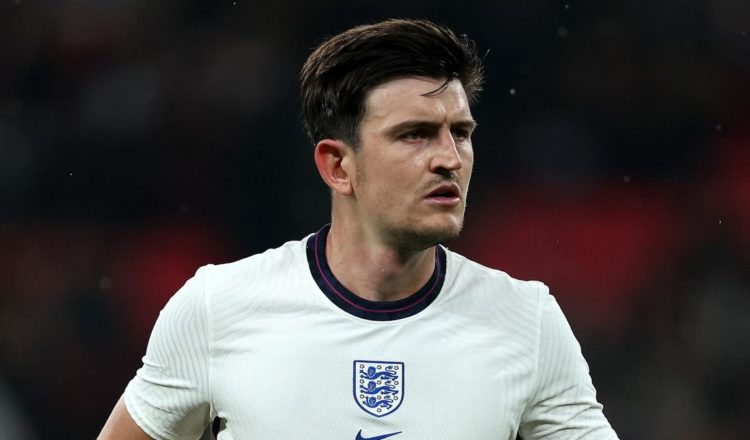England manager Gareth Southgate was correct in taking Manchester United’s Harry Maguire to the 2022 World Cup, according to former Three Lions defender Joleon Lescott.

The decision to take Maguire was met with criticism due to the United man’s poor form for his club side, as well as his absence from Erik ten Hag’s starting XI in the run-up to the Qatar showpiece.
But speaking exclusively to Warner Bros Discovery Sport, Lescott believes there are so many other factors at play.
“I think it’s key that you have a connection with your [centre-back] partner, I think that definitely helps,” Lescott tells WBD Sport of the decision to take the experienced Maguire.
“Is it a necessity? I’m trying to think, in 2012 I don’t think me and John Terry had played together that much on a regular basis. We played together every time I think I was in the squad. So it was probably slightly different for him. Because he was then having to go over to the right-hand side.
“I don’t think it’s just simply down to games he’s played or the form he’s in. I think there’s so much more that has to be considered to the squad dynamic.
“There are so many things that factor into all the selection processes. I think the majority of them are simple: There’s quality, you can perform, yes, when picked, but then you’re thinking how does he train and what’s he like when he’s not selected? Is he still the leader that we expect? And I’m not just talking about Maguire, I’m talking other members of the squad. But Gareth knows all that as he’s seen it.”
One of the bigger talking points is what formation Southgate will use, with most reports suggesting that he will return to the back three system that has served England so well in the past two tournaments.
Another suggestion has been to play with a back four in the group stages, where England are heavy favourites to qualify, but then switch to a back three in the knockouts. However Lescott believes that continuity with the system will put the players in the best position to succeed.
He said: “Yes you could get away with it [starting with a back four then switching] because I still believe we qualify. But again, does that mean you get away with it for that and then you lose the first knockout or one of the early knockout stages and everyone is going to be like ‘well, you should have done this’.
“For me personally, I think he will probably go with the formation that you want to play with for the majority of the tournament and I agree with that because I just think it gives players the opportunity to then be exposed to scenarios they’re going to face if you’re going to play a France, Holland or Portugal etc, and all of a sudden you’re receiving the ball in a different area and a scenario where it’s totally different to what you’ve done in the groups.
“It’s just a new experience and again, all these players are experienced, all these players are quality. We know how the scrutiny is, how much it’s highlighted differently when it’s England. So I think to give the players the best opportunity would be to play the same formation but rotate the personnel, because I do believe that is key.”
A former defender himself, Lescott was a versatile option being fully capable of playing at both left-back and centre-back. He tells WBD Sport that he would have loved to play in a system like this one.
“As I said I’ve played full-back and enjoyed getting forward but I love to defend and it was an opportunity to probably defend a little bit more one on one which I enjoyed doing,” Lescott said. “That was probably the biggest plus for me playing as a full-back. It was being able to say I’m against someone that wants to take me on, you’re against different scenarios and you have to defend.”
He also offers the tantalising alternative universe where the England team he played in opened up their options in terms of formation (rather than the traditional 4-4-2) and used a back three. He suggested a back three of himself, Rio Ferdinand and John Terry. Then players like Ashley Cole, Leighton Baines, James Milner and Glen Johnson as wing-backs. The likes of Steven Gerrard, Frank Lampard, Owen Hargreaves and Michael Carrick in midfield. And up front, two of Wayne Rooney, Joe Cole, Jermain Defoe and Peter Crouch etc. It’s certainly a tasty proposition.
But as a defender, what are the biggest differences and intricacies that come with changing from a back four to a back five?
Lescott said: “I think the biggest difference is the areas you are defending, you’re probably a little bit wider. So it’s a bit more spatial. Your recovery runs are a little bit different. You have to cover wider areas of the field, but I don’t think it’s totally new to anyone.
“I believe what defenders now should be doing is delaying. Like when you’re going towards them [attackers] in wide areas it’s not a case of ‘Oh I need to win the ball’ it’s ‘Okay I need to delay this attack, which allows my teammates to recover’. So again, it’s just understanding that relationship a little bit more, understanding the most comfortable position, so I think they’ll probably enjoy the freer nature compared to a two anyway because you get on the ball a little bit more.
“When it’s a two and you see the split it’s harder to recover. You’re creating such a big angle and the right angle to receive and for your teammates to receive.
“And if it doesn’t go to plan the recovery run can sometimes be unachievable. Sometimes when trying to split, the middle player gets the ball and all of a sudden it’s like ‘Oh, he’s lost it now your centre-backs can’t get inside’ but when it’s a three there’s always going to be someone around there. So it’s slightly different for that aspect as well.”













